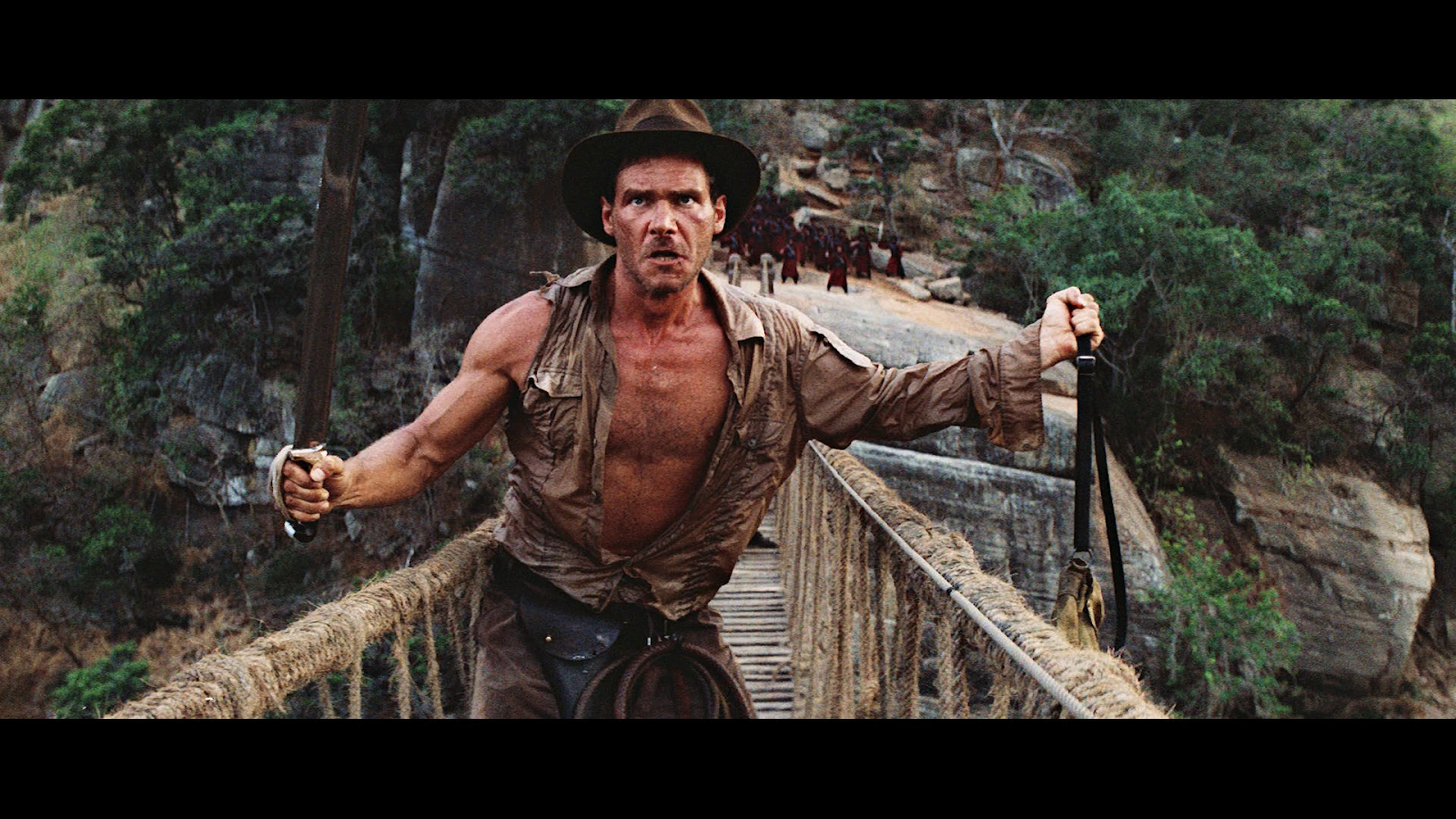
* * * *
Okay, it wasn’t quite as bad – crossing that “swinging bridge” the first day on the Chilkoot Trail – as it was for Indiana Jones in the photo above. (For example, we hadn’t been “cornered by Mola Ram and his henchmen on a rope bridge high above a crocodile-infested river.”)
But that second day on the Trail was pretty &^%$ bad… In case you hadn’t noticed, this continues Part 1 of “On the Chilkoot &^%$# Trail!” We left Part 1 with we three – brother, nephew and I – all having made Sheep Camp by 7:30 p.m. on the first day of the hike.
13 miles or so – nobody seems sure how many – by 7:30 p.m… That included crossing the swaying footbridge … à la Indiana Jones and the Temple of Doom.
(Reprised in the photo above right.) Part 1 also included the tale of a “young thing” I managed to insult on the second day of the hike – approaching the summit of Chilkoot Pass – and how most or all us hikers met up again – on the fourth day – waiting for the 3:15 train back to Skagway.
But I had to cut it short – and make this a two-parter – because I was “approaching the limit of the ideal length for a blog-post.” (About 1,200 words.) So now, back to Day 1 of the hike.
On Monday August 1, we left the trailhead – near “Die-eee” – at 9:00 a.m. We made Sheep Camp by 7:30 that night, and after getting situated I managed to write a little something in the notebook I’d packed. I wrote: “I’m shivering as I’m writing. I’ve been sweating all day despite the cool 68-degree temps. And now it’s turning cool, so I’m shivering.” I then added:
There were many times – many times – today when I wondered what the hell I was doing here. And that this was just too far to go in one day. And I like hiking at my own pace. Rather than always bringing up the rear… So today was the tough one, as far as miles traveled. “Only” eight miles, but we’ll be climbing the Pass [tomorrow]. BTW: I just had my fifth swallow of “O be joyful.”
 So here’s another side note: “O Be Joyful” was our code-word for ardent spirits. We started packing them – in past canoe trips, like down the Missouri River from Fort Benton, MT – as a way of following in the footsteps of Lewis and Clark, and other American pioneers.
So here’s another side note: “O Be Joyful” was our code-word for ardent spirits. We started packing them – in past canoe trips, like down the Missouri River from Fort Benton, MT – as a way of following in the footsteps of Lewis and Clark, and other American pioneers.
You see, back in the old days of our country, whiskey – for example – was used instead of hard currency:
One of the first media of exchange in the United States was classic whiskey. For men and women of the day, the alcohol did more than put “song in their hearts and laughter on their lips.” Whiskey was currency. Most forms of money were extremely scarce in our country after the Revolutionary War, making monetary innovation the key to success.
See Why Whiskey Was Money, and Bitcoins Might Be. So it was in that spirit – primarily – that I took a flask of “O be joyful” along on the Chilkoot. Be that as it may, after I wrote, “I just had my fifth swallow of ‘Oh be joyful,’” I then added, “Which helps a lot.”
(I wasn’t so sure about the “song in my heart and laughter on my lips…”)
Also on the evening of August 1st, I wrote that the campground was more crowded than I expected. And that in the audience – listening to a lecture by a ranger when we arrived – there were some cute women, but “romance is the last thing on my mind tonight.”
(Which itself was telling…) I concluded, “Altogether a good day. I had my doubts, which were justified in a way, but ‘we’ came through. Albeit with me bringing up the rear the whole day.”
 On that note, I “brought up the rear” the next day as well, and for pretty much the rest of the hike.
On that note, I “brought up the rear” the next day as well, and for pretty much the rest of the hike.
Which brings up the fact that hiking the Chilkoot Trail is sheer torture for someone – like me – with only one good eye and and thus no depth perception.* And that applied even on the relatively smooth parts of the trail, like the section shown at right.
Also – as mentioned in the notes – anyone hiking the trail is advised that if they have to get airlifted out, the cost will be a cool $28,000.00. Which brings up another point rangers make in the process of getting your permit to hike the trail: Watch out for the bears!
For one thing, the general rule is “no chow in your tent.” Each camp has a tented-in dining facility,* and there – and only there – are you supposed to eat. Eating on the trail can be messy, and the usual solution for crumbs or spills is to wipe the stuff off on your pants. But bears have an extremely keen sense of smell, and so some crumbs in your pocket or syrup from a snack-cup on your pants could lead to an extremely unpleasant midnight visit.
But for me the message distilled down to this: You don’t have to be faster than the bear. You only have to be faster than the others in your party. (Which of course spelled trouble for me…)
But once again we digress… The point is that eventually – in our case, the second day – we got past the smooth parts of the trail and began approaching the summit. It got so bad for me – after we got up and over the summit – that first my brother and then my nephew left their packs ahead and came back and carried my pack for a while. Which led to its own problems. Much like the phantom limb phenomenon, the “phantom pack” syndrome leaves you disoriented. Especially when negotiating “one big pile of *&^% rocks after another,” you end up walking like the proverbial drunken sailor, weaving to and fro.
 Finally – after much anguish – you get to and over the summit. But as noted, things don’t get any easier. There – on the other side of the summit of Chilkoot Pass – were at least three “glaciers,” or ice-fields. (Like the one at right.) My first reaction was: “Great! Nice smooth snow to walk on!”
Finally – after much anguish – you get to and over the summit. But as noted, things don’t get any easier. There – on the other side of the summit of Chilkoot Pass – were at least three “glaciers,” or ice-fields. (Like the one at right.) My first reaction was: “Great! Nice smooth snow to walk on!”
But these glacier-slash-ice-fields were just as treacherous, though in a different way. My fellow hikers hadn’t relieved me of my pack yet, so walking on the slippery snow led to several falls.
It got so bad that finally I stayed down – on the snow-slash-glacier – and slip-slid to the end. That got my pants and boots thoroughly wet in the process, but at least – for a moment or two – I wasn’t struggling over “one big pile of &^%$ rocks after another.”
Somewhere in there I slipped and fell on some rocks, banging my right knee enough that by Thursday, at Bennett, that area of my jeans was covered with crusted blood.
Which leads to my confession – I “do not deny, but confess” – that there were times on the Trail when if I could have cried I would. (But that wouldn’t have helped the pain in my feet, or made the journey any shorter.) Which brings us to the late afternoon and evening of the second day.
 Along with the usual “one big pile of &^%$ rocks after another” – and the three “glaciers” noted above – the other side of the pass featured a seemingly-endless series of streams and/or rivulets like the one at left. They too were beautiful, but treacherous. (I was going to say “like some women I know,” but decided against that.)
Along with the usual “one big pile of &^%$ rocks after another” – and the three “glaciers” noted above – the other side of the pass featured a seemingly-endless series of streams and/or rivulets like the one at left. They too were beautiful, but treacherous. (I was going to say “like some women I know,” but decided against that.)
I know my brother took a spill or two – and got an infected elbow as a result – but mostly because he told me so later.
And as far as I know my nephew did okay crossing the many “beautiful but treacherous” streams, but not from any personal observation. He – and my brother as well – were usually so far out in front of me that I often lost sight of them.
Then it started getting dark.
Back at the hotel in Skagway – before we left – it was still light as late as 10:00 p.m. Therefore – I deduced – we should have plenty of hours to hike on the Trail. But for some reason it got darker earlier on the Trail, which meant that by 7:00 p.m. or so my brother started getting worried. The result was that in the fullness of time – just in time – we had a little parade.
To make a long story short, my brother went ahead the couple of miles to Happy Camp, dropped his pack and hiked back to where I was. He carried my pack for a bit, then some strapping young lad showed up. He – the strapping young lad – had heard someone at Happy Camp talk about my struggles, and decided to come back and help. (Apparently we – or at least I – became quite a conversation piece around Happy Camp that night…)
So the strapping young lad carried my pack a while – “jabbering all the way,” my brother said – and finally my nephew came back. He had also dropped his pack at Happy Camp and then he carried my pack the final mile and a half. That was my brother’s recollection.
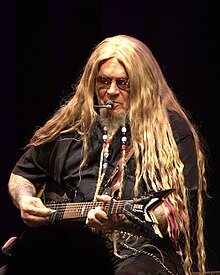 All I remember is that along about 7:30, I could see some people on the Trail ahead of me. Eventually I limped up to where my brother and nephew were. Also there were the aforementioned “strapping young lad,” along with a nice white-haired Canadian ranger lady who called me by my name. (They keep tabs on all hikers on the Trail.)
All I remember is that along about 7:30, I could see some people on the Trail ahead of me. Eventually I limped up to where my brother and nephew were. Also there were the aforementioned “strapping young lad,” along with a nice white-haired Canadian ranger lady who called me by my name. (They keep tabs on all hikers on the Trail.)
From that point, we all set off toward Happy Camp. The nice ranger-lady followed behind me, engaging me in conversation. (Probably trying to keep my mind off my aching feet.) So, eventually we all made it to Happy Camp, and that’s how we “had a little parade.” But this time I wasn’t bringing up the rear. (For once.)
On that note – and as described in Campgrounds of the Chilkoot Trail:
Happy Camp is the only campground on the Chilkoot Trail in the alpine… Happy Camp owes its name to the relief prospectors (and hikers) experienced from arriving at the first outpost after the pass. The camp is situated in a true alpine ecosystem and receives heavy use because of its location.
Personally, I can vouch for the “relief” part. And it got better. (At least for that night.)
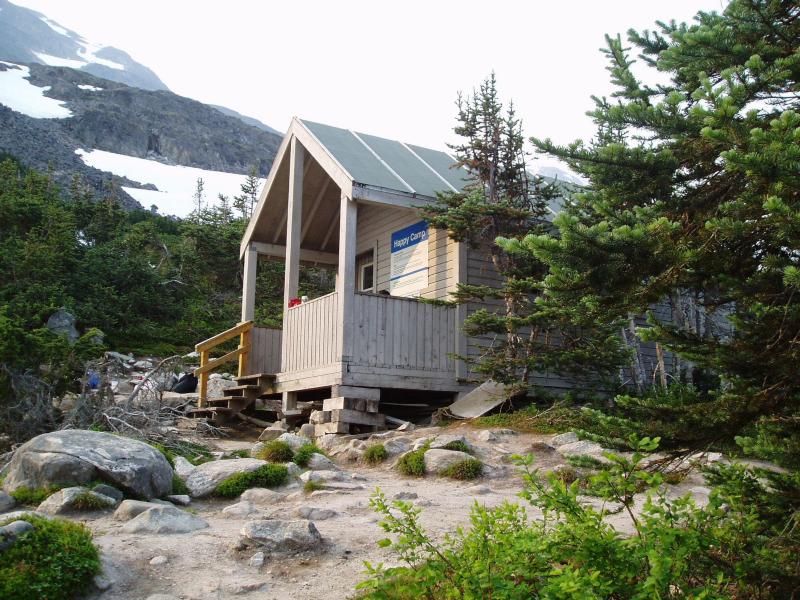 Apparently the nice white-haired Canadian ranger lady felt sorry for us. (Or at least for me.) So she let the three of us use her personal shelter tent. That is, she said she had to get up early the next morning for some meeting elsewhere on the Trail, so she’d stay in main – wooden – shelter at Happy Camp, shown at left.
Apparently the nice white-haired Canadian ranger lady felt sorry for us. (Or at least for me.) So she let the three of us use her personal shelter tent. That is, she said she had to get up early the next morning for some meeting elsewhere on the Trail, so she’d stay in main – wooden – shelter at Happy Camp, shown at left.
That meant the three of us didn’t have to set up our tents in the waning light of that second day on the Trail.
It also meant that two of us got to sleep on cots. (My nephew slept on his air mattress on the floor, despite my saying I’d sleep on the floor. But I made it up to him – for carrying my pack – by splitting two six-packs of beer once we got back to Skagway, as described elsewhere.) And finally, the nice white-haired Canadian ranger lady brought us each a juice-box.
And a sweeter nectar I’ve never tasted.
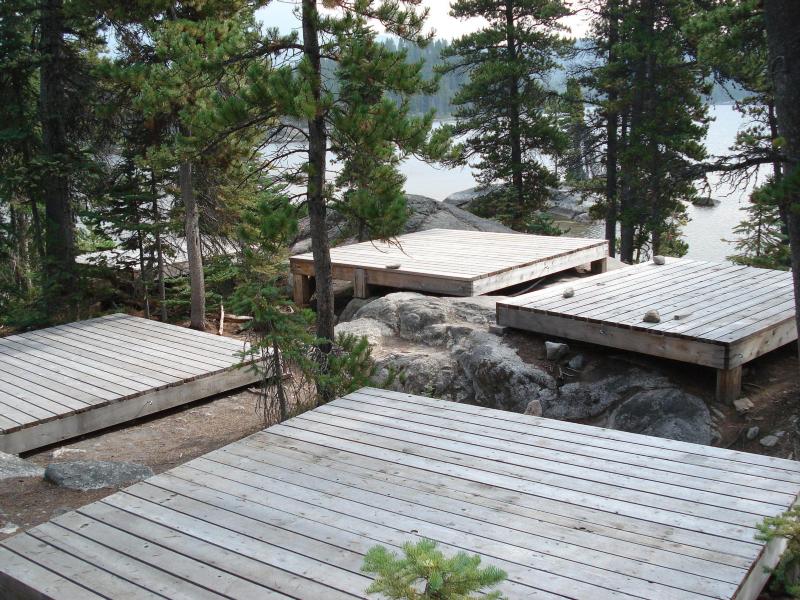 From that point the rest of the hike is a blur. I know we made it next day to the campground at Bare Loon Lake. (Which included numerous tent platforms like the ones at right.)
From that point the rest of the hike is a blur. I know we made it next day to the campground at Bare Loon Lake. (Which included numerous tent platforms like the ones at right.)
And I know that that left only four miles to do the next day, Thursday, to get to the railroad station at Bennett. And that rangers and other hikers kept saying the Trail would get easier and smoother “a mile or so further along.”
But it never happened. At least not until a mile or so from the station, when the Trail got wide and sandy. In fact the Trail at that point was pretty much like walking on the beach. Which of course presented its own different challenges, but at that point I wasn’t complaining. (Much.)
Thursday, August 4, 1:20 Alaska Time. We’re at the Bennett railroad station. Got here at 12:05 AT. I’ve set up my tent to dry it off – it rained last night – and heated up some water… Spilled some walking back across the tracks. (“No open fires.”) But there was enough left over to make hot coffee. For the first time since Monday morning. The right knee of my jeans is covered with blood. The ankle areas are dried mud. I have two or three large blisters, one each inner heel, that have already popped. And one large blister on the right big toe that looks about to pop. Huge! But right now the world looks great!
That’s what I wrote in the notebook I’d packed, writing in it for the first time since Monday. So there – at the railroad station that would remain unmanned until the 3:15 arrived – the right knee of my jeans was crusted with dry blood. And my feet were blistered and beyond sore.
Which is another way of saying they don’t call the Chilkoot Trail “the meanest 33 miles in history” for nothing. Meanwhile, I had one final point to be made. I made it via email – to the folks back home – once the three of us got back to Skagway: “I used up my quota of expletives for the next couple of years, so any prayers in my direction would help immensely.”
So now, to paraphrase that great philosopher, Forrest Gump:
“That’s all I have to say about the Chilkoot &$%# Trail!”

* * * *
Unless otherwise noted, the images in this post – including the photos at the bottom and top of the page – are ones I took during the aforementioned “hike.” (More like sheer torture…)
For example, the image at the top of the page is courtesy of happyotter666.blogspot.com. See also Indiana Jones and the Temple of Doom – Wikipedia, which provided the “cornered” quote.
Re: “O be joyful.” See also Definition of oh be joyful – Online Slang Dictionary, and/or O-be-joyful – 17 of the Finest Words for Drinking.
Re: Whiskey and other “ardent spirits” used as currency. See also TTB.gov Alexander Hamilton And The Whiskey Tax: “small farmers on the young Nation’s western frontier in the Appalachian Mountains, often distilled whisky from their surplus corn crop. This whisky was then often used as a form of currency on the cash-strapped frontier.”
 Re: “No depth perception.” As illustrated by the image at right – courtesy of lookfordiagnosis.com – imagine trying to negotiate “one big pile of &^%$ rocks after another,” with no depth perception. And while trying maintain enough speed to keep up with your brother and nephew, while seeing the “piles of &^%$ rocks” as a blur. (As in the background at right.) And with the full knowledge that one bad move – one twisted knee or ankle – will cost you a cool $28,000 to get airlifted out. (That’s what they told us in Skagway when we got our permits. Meaning it’s happened often enough that they have the figures down pat.)
Re: “No depth perception.” As illustrated by the image at right – courtesy of lookfordiagnosis.com – imagine trying to negotiate “one big pile of &^%$ rocks after another,” with no depth perception. And while trying maintain enough speed to keep up with your brother and nephew, while seeing the “piles of &^%$ rocks” as a blur. (As in the background at right.) And with the full knowledge that one bad move – one twisted knee or ankle – will cost you a cool $28,000 to get airlifted out. (That’s what they told us in Skagway when we got our permits. Meaning it’s happened often enough that they have the figures down pat.)
 Re: “No chow in your tent.” The photo at left – courtesy of Campgrounds of the Chilkoot Trail – Wikipedia – shows both a “dining shelter” in the background, and in the foreground a ranger at Sheep Camp giving a lecture like the one in the main text. Also, “Rangers recommend 7.5 to 10 hours for a group to travel from Sheep Camp to Happy Camp.” We took longer than that…
Re: “No chow in your tent.” The photo at left – courtesy of Campgrounds of the Chilkoot Trail – Wikipedia – shows both a “dining shelter” in the background, and in the foreground a ranger at Sheep Camp giving a lecture like the one in the main text. Also, “Rangers recommend 7.5 to 10 hours for a group to travel from Sheep Camp to Happy Camp.” We took longer than that…
Re: “Called Me by My Name.” The allusion is to a song by David Allan Coe. (Which – incidentally – is one of my signature karaoke songs.) The photo shows Coe on stage in 2009. It is not intended to refer in any way to the “nice white-haired Canadian ranger lady.” That nice white-haired Canadian ranger lady should – in my estimation – be elevated to sainthood, along with Mother Teresa.
Re: The juice boxes and “sweeter nectar.” My brother said his was grape juice, but I could have sworn that mine was “raisin.” I remember thinking that it was such an odd flavor for a juice box, but I couldn’t find any such flavor on the internet. (Or maybe I was in a state of delirium.) One thing I do know: No matter what the flavor, that juice box – at that point in time – was delicious!
The lower image is courtesy of that’s all i have to say about that – Forrest Gump – quickmeme.

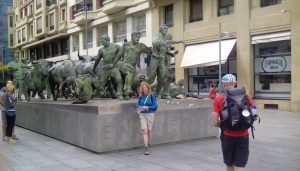
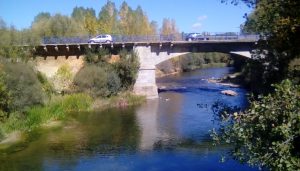

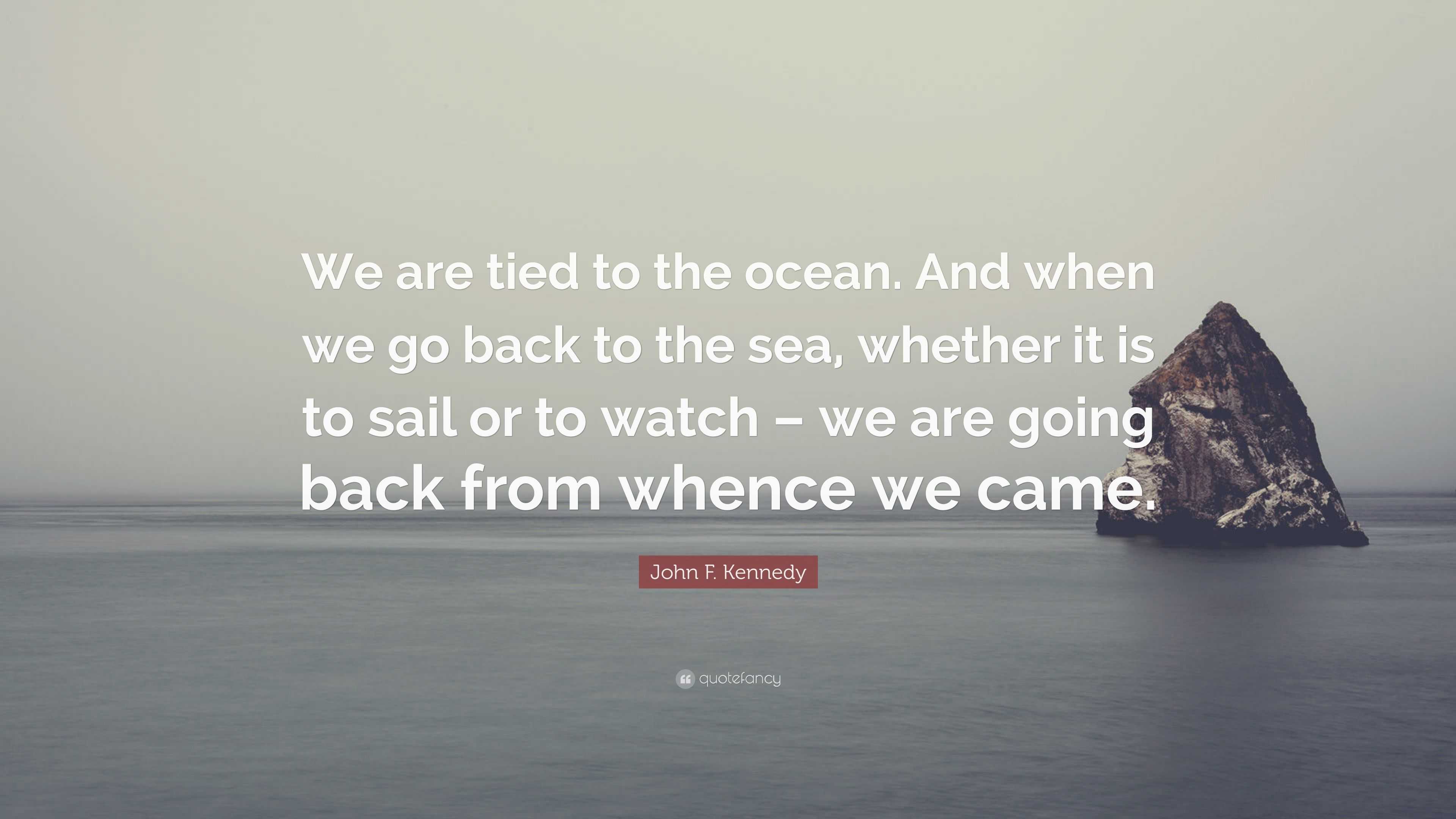 Within 48 hours I’ll be winging my way from Atlanta to
Within 48 hours I’ll be winging my way from Atlanta to 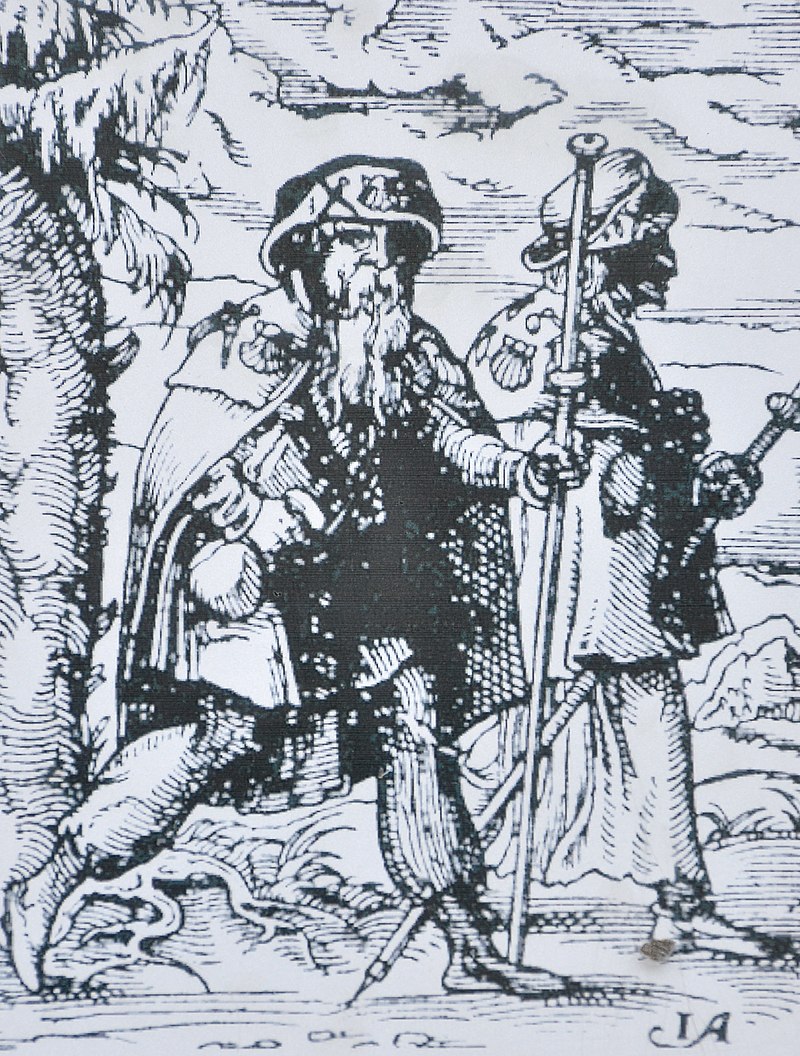 Which pretty much sums up the whole idea of going on a
Which pretty much sums up the whole idea of going on a 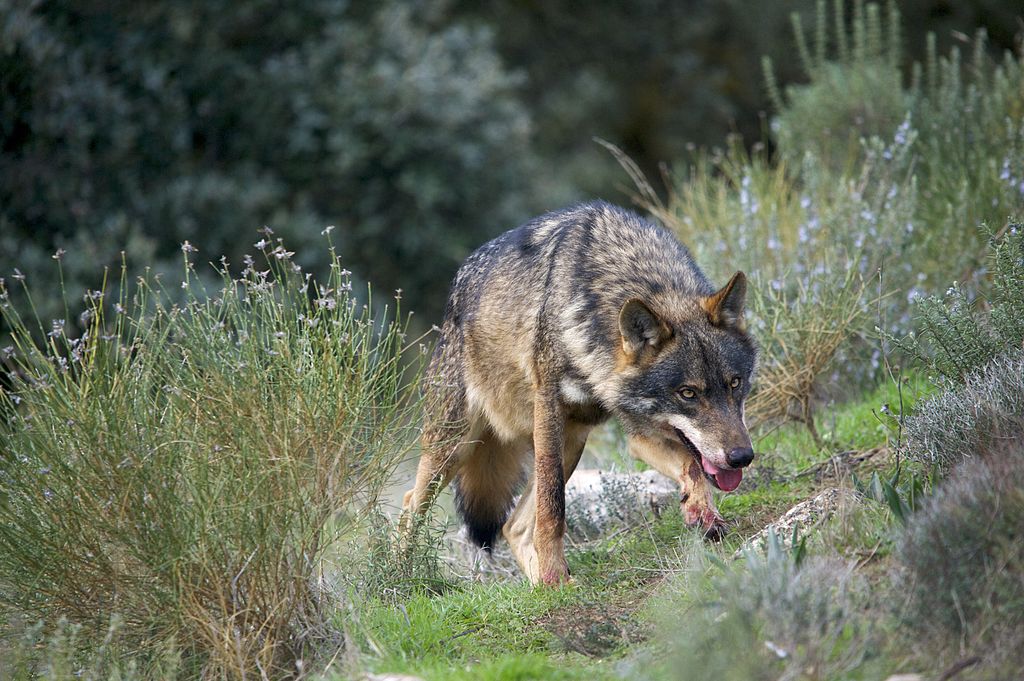 I also didn’t know about the
I also didn’t know about the  The
The .jpg)
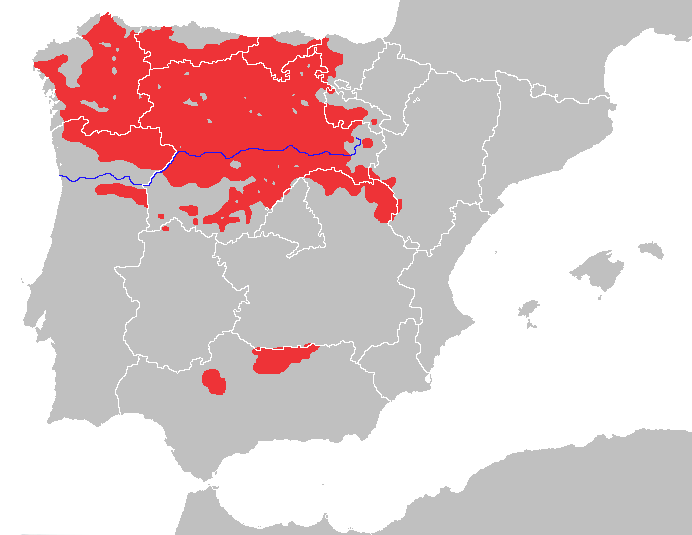

 I described those adventures in
I described those adventures in  Things like my upcoming
Things like my upcoming  Which could be a personal problem. And for that matter there was also very little privacy on the Chilkoot Trail.
Which could be a personal problem. And for that matter there was also very little privacy on the Chilkoot Trail. You could get all the necessary prep-info from the websites noted above, or other informative sites. Or, you could have an ex-Marine
You could get all the necessary prep-info from the websites noted above, or other informative sites. Or, you could have an ex-Marine 
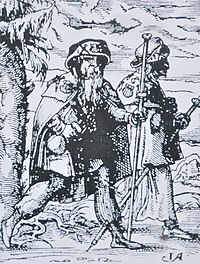 July 19, 2017 – In September I’m flying to
July 19, 2017 – In September I’m flying to 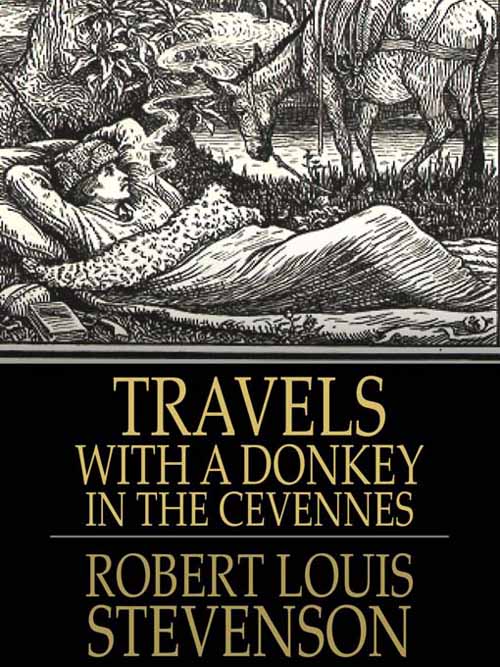 I still don’t know the full answer, except to say that such
I still don’t know the full answer, except to say that such  Re:
Re:  There was of course the
There was of course the 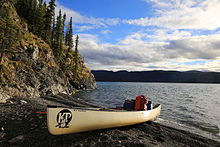 After that my nephew had the good sense to head back east to begin classes at Penn State. However, my brother and I proceeded on to a twelve-day canoe trip “down” the Yukon River. We ended up in
After that my nephew had the good sense to head back east to begin classes at Penn State. However, my brother and I proceeded on to a twelve-day canoe trip “down” the Yukon River. We ended up in  One of the highlights hiking the trail came as we three were approaching the summit of the Chilkoot Pass. (My brother and nephew were way out in front. And at left is the good part.)
One of the highlights hiking the trail came as we three were approaching the summit of the Chilkoot Pass. (My brother and nephew were way out in front. And at left is the good part.)  Which is enough – for now – about the naked lady on the Yukon.
Which is enough – for now – about the naked lady on the Yukon.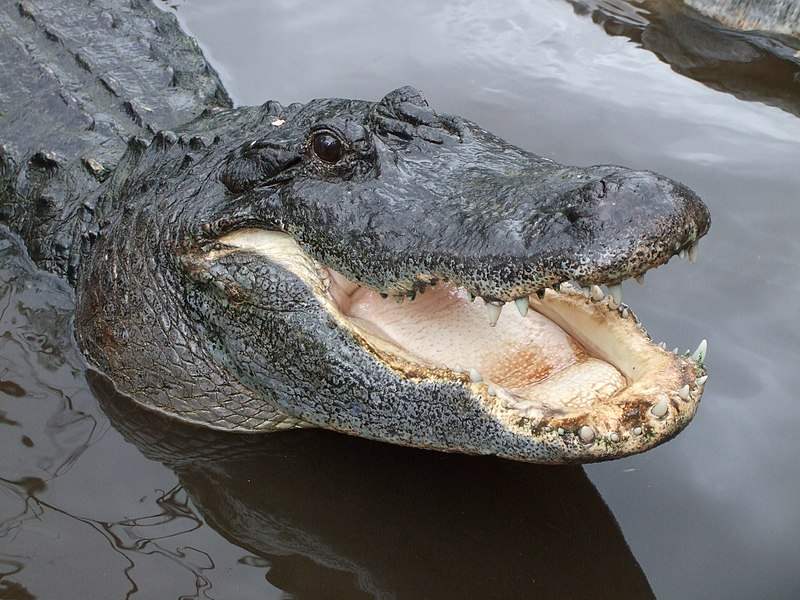

 The following day I had an NTE. (Near-Ticket Experience, an allusion to an
The following day I had an NTE. (Near-Ticket Experience, an allusion to an 
 The title of this post is a take-off on the film,
The title of this post is a take-off on the film,  Which is ironic. That’s because people my age are
Which is ironic. That’s because people my age are  Of course much of the time I did feel like I was surrounded by a bunch of “furriners” in the
Of course much of the time I did feel like I was surrounded by a bunch of “furriners” in the  Then we finally got on the bus, and as we rode down the toward the district, we heard a lot of sirens. Then we passed a street or two that had been blocked off – as seen at left – and all kinds of murmuring crowds.Then we finally got on the bus, and as we rode down the
Then we finally got on the bus, and as we rode down the toward the district, we heard a lot of sirens. Then we passed a street or two that had been blocked off – as seen at left – and all kinds of murmuring crowds.Then we finally got on the bus, and as we rode down the  Back home this would come under the heading
Back home this would come under the heading 
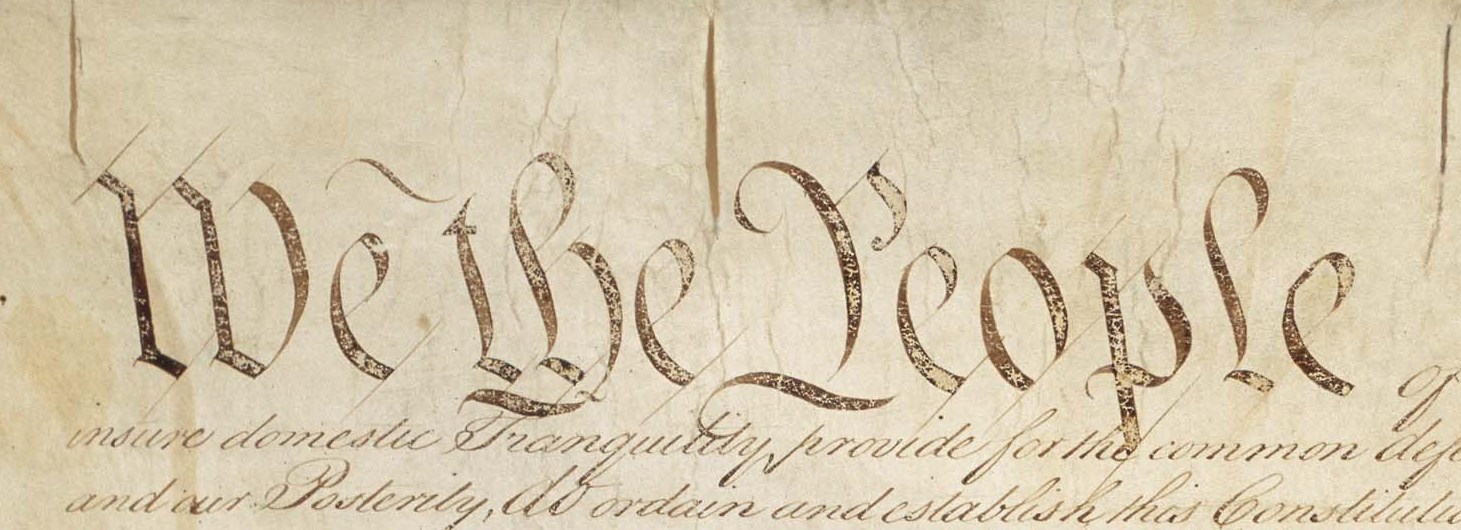 Which brings up the fact that way too many people interpret both the Bible and the
Which brings up the fact that way too many people interpret both the Bible and the  Finally – on this topic – It also seems to me that the “just a poem” guy probably bears a passing resemblance to the man shown at the bottom of the page. (At least metaphorically…)
Finally – on this topic – It also seems to me that the “just a poem” guy probably bears a passing resemblance to the man shown at the bottom of the page. (At least metaphorically…) Once we got over to the city, we took another subway ride up to the start of the “
Once we got over to the city, we took another subway ride up to the start of the “ Meaning in turn that – to way too many people these days – “liberty” must be preserved for only those who “already have it.” (See
Meaning in turn that – to way too many people these days – “liberty” must be preserved for only those who “already have it.” (See  Also in
Also in 
 Re:
Re:  So here’s another side note: “
So here’s another side note: “ Finally – after much anguish – you get to and over the summit. But as noted, things don’t get any easier. There – on the other side of the summit of Chilkoot Pass – were at least three “glaciers,” or ice-fields. (Like the one at right.) My first reaction was: “Great! Nice smooth snow to walk on!”
Finally – after much anguish – you get to and over the summit. But as noted, things don’t get any easier. There – on the other side of the summit of Chilkoot Pass – were at least three “glaciers,” or ice-fields. (Like the one at right.) My first reaction was: “Great! Nice smooth snow to walk on!” Along with the usual “one big pile of &^%$ rocks after another” – and the three “glaciers” noted above – the other side of the pass featured a seemingly-endless series of streams and/or rivulets like the one at left. They too were beautiful, but treacherous. (I was going to say “like some women I know,” but decided against that.)
Along with the usual “one big pile of &^%$ rocks after another” – and the three “glaciers” noted above – the other side of the pass featured a seemingly-endless series of streams and/or rivulets like the one at left. They too were beautiful, but treacherous. (I was going to say “like some women I know,” but decided against that.) All I remember is that along about 7:30, I could see some people on the Trail ahead of me. Eventually I limped up to where my brother and nephew were. Also there were the aforementioned “strapping young lad,” along with a nice white-haired Canadian ranger lady who
All I remember is that along about 7:30, I could see some people on the Trail ahead of me. Eventually I limped up to where my brother and nephew were. Also there were the aforementioned “strapping young lad,” along with a nice white-haired Canadian ranger lady who  Apparently the nice white-haired Canadian ranger lady felt sorry for us. (Or at least for me.) So she let the three of us use her personal shelter tent. That is, she said she had to get up early the next morning for some meeting elsewhere on the Trail, so she’d stay in main – wooden – shelter at Happy Camp, shown at left.
Apparently the nice white-haired Canadian ranger lady felt sorry for us. (Or at least for me.) So she let the three of us use her personal shelter tent. That is, she said she had to get up early the next morning for some meeting elsewhere on the Trail, so she’d stay in main – wooden – shelter at Happy Camp, shown at left. From that point the rest of the hike is a blur. I know we made it next day to the campground at
From that point the rest of the hike is a blur. I know we made it next day to the campground at  Re: “No
Re: “No  Re: “No chow in your tent.” The photo at left – courtesy of
Re: “No chow in your tent.” The photo at left – courtesy of